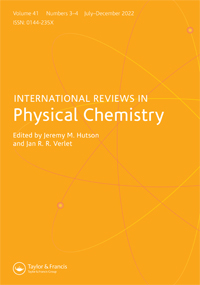金属配合物的低温和温度依赖光电子能谱
IF 2.5
2区 化学
Q3 CHEMISTRY, PHYSICAL
引用次数: 7
摘要
负离子光电子能谱(NIPES)与电喷雾电离(ESI)耦合已被证明是表征电子结构、各种簇阴离子的化学键以及参与缩合相反应和转化的相应中性自由基的有力气相光谱工具。由于获得了低温和温度控制能力,研究范围越来越广。本文综述了近年来利用低温ESI-NIPES对金属配合物的研究,这些研究为理解复杂的缩合相反应提供了重要信息,包括碳氢化合物活化和电子转移反应,并提供了高活性瞬态物质和亲密氧化还原对的光谱视角。特别注意气相光剥离过程与溶液氧化还原反应的联系。过渡金属- edta配合物的光剥离已被系统地研究,以模拟这些物种在溶液中的顺序氧化反应。对于每个系列的同源金属配合物,将得到的气相电子亲和(EA)与溶液氧化还原电位(E1/2)和金属电离电位(IP)进行比较,以强调它们的内在相关性,偏差在很大程度上由不同程度的配体参与来调节。本文章由计算机程序翻译,如有差异,请以英文原文为准。
Cryogenic and temperature-dependent photoelectron spectroscopy of metal complexes
Negative ion photoelectron spectroscopy (NIPES) coupled with electrospray ionisation (ESI) has been proven to be a powerful gas-phase spectroscopic tool for characterising electronic structures, chemical bonding of a variety of cluster anions, and corresponding neutral radicals involved in the condensed phase reactions and transformations. Since the acquisition of cryogenic and temperature-controlling capabilities, a broader range of research has been covered. This review summarises our recent investigations on metal complexes employing cryogenic ESI-NIPES that provides essential information towards understanding complicated condensed phase reactions, including hydrocarbon activations and electron transfer reactions, and affords spectroscopic perspective of highly reactive transient species and intimate redox pairs. Special attention has been drawn to connect gas phase photodetachment processes with solution phase redox reactions. Photodetachment of transition metal-EDTA complexes has been systematically investigated to model the sequential oxidation reactions of these species in solutions. For each series of homologous metal complexes, the obtained gas phase electron affinity (EA) is compared with the solution redox potential (E1/2) and the metal ionisation potential (IP) to emphasise their intrinsic correlations, with deviations being largely modulated by different degrees of ligand participations.
求助全文
通过发布文献求助,成功后即可免费获取论文全文。
去求助
来源期刊
CiteScore
14.20
自引率
1.60%
发文量
5
审稿时长
1 months
期刊介绍:
International Reviews in Physical Chemistry publishes review articles describing frontier research areas in physical chemistry. Internationally renowned scientists describe their own research in the wider context of the field. The articles are of interest not only to specialists but also to those wishing to read general and authoritative accounts of recent developments in physical chemistry, chemical physics and theoretical chemistry. The journal appeals to research workers, lecturers and research students alike.

 求助内容:
求助内容: 应助结果提醒方式:
应助结果提醒方式:


